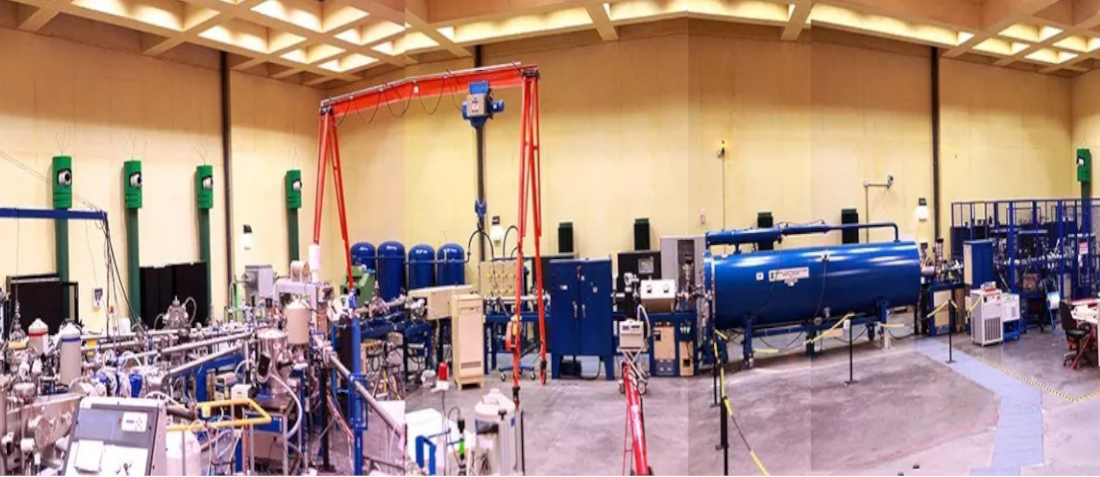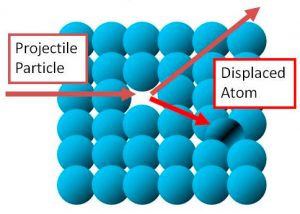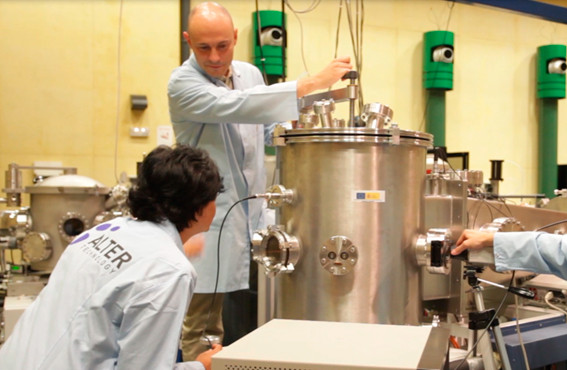
How and Why to Test for Displacement Damage
- Posted by Manuel Padial Pérez
- On November 16, 2020
- 0
Displacement Damage
Displacement Damage is the result of nuclear interactions, typically scattering, which cause lattice defects. Displacement damage degrades minority carrier lifetime; a typical effect would be the degradation of gain and leakage current in bipolar transistors.

FIGURE: Principle of Displacement Damage
Atomic displacement can occur mainly ballistically through kinetic energy transfer. As a charged particle passes through matter, the particle energy dissipates by exciting orbital electrons and by elastic collisions with the material nuclei. Displacement damage is due to cumulative long-term non-ionizing damage from the ionizing radiations. The collision between an incoming particle and a lattice atom subsequently displaces the atom from its original lattice position. In space, the particles producing displacement damage include protons of all energies, electrons with energies above 150 keV, and neutrons.
Atomic displacement can occur mainly ballistically through kinetic energy transfer. As a charged particle passes through matter, the particle energy dissipates by exciting orbital electrons and by elastic collisions with the material nuclei. Displacement damage is due to cumulative long-term non-ionizing damage from the ionizing radiations. The collision between an incoming particle and a lattice atom subsequently displaces the atom from its original lattice position. In space, the particles producing displacement damage include protons of all energies, electrons with energies above 150 keV, and neutrons.
An elastic collision can eject an atom from its normal lattice position. The ejected atom is known as a primary knock-on, which, in turn, may cause a cascade of atomic displacements before eventually coming to rest.
As can be seen in the figure above, the displaced atom becomes an interstitial, and the position the atom formerly occupied becomes a vacancy. Some displaced atoms can lead to secondary displacements. For example, the displaced atom may collide with and replace another atom in the material.
When Displacement Damage happens, the incident particle creates defects by colliding with an atom of the crystal (recoil atom) which provokes damage to the electrical characteristics of certain devices. The Displacement Damage test consists in measuring parameter drifts for different proton fluences.
Typical energies used for this test are:
- 50 – 60 MeV for proton test energy,
- 10 MeV for detector arrays, and
- 1-3 MeV electrons and 3 – 10 MeV protons for solar cells
Ideally, the specimens should be examined at several energy levels.
Displacement damage depends on the non-ionizing energy loss, i.e. energy and momentum transfer to lattice atoms, which depends on the mass and energy of the incident quanta. A simple measure as for ionizing radiation is not possible so that displacement damage must be specified for a specific particle type and energy.

FIGURE: Displacement Damage set-up.
Displacement damage manifests itself in three important ways:
- Formation of mid-gap states, which facilitate the transition of electrons from the valence to the conduction band. In depletion regions, this leads to a generation current, i.e. an increase in the current of reverse-biased PN-diodes. In forwarding biased junctions or non-depleted regions mid-gap states facilitate recombination, i.e. charge loss.
- States close to the band edges facilitate trapping, where a charge is captured and released after a certain time.
- A change in doping characteristics (donor or acceptor density) (1)
(1) Source: Introduction to Radiation-Resistant Semiconductor Devices and Circuits, Helmuth Spieler, Ernest Orlando Lawrence Berkeley National Laboratory
CONTACT US
⇒
- Hi-Rel Intermediate bus converter and point of load - December 11, 2021
- ASIC or FPGA, how to choose between them - October 25, 2021
- Ceramic Hermetic DDR2 SDRAM Memory avalaible for Space - September 13, 2021


0 comments on How and Why to Test for Displacement Damage